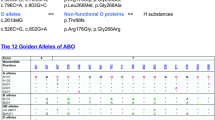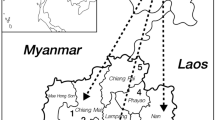Summary
DNA sequence analysis of the polymerase chain reaction products, including the coding region for amino acids 416 and 420, of the vitamin-D-binding protein (DBP, group-specific component, GC) shows allelespecific differences. The GC2 and GC1F phenotypes have an aspartic acid residue at amino acid position 416, whereas the GC1S phenotype has a glutamic acid at this position. In the GC2 phenotype, amino acid 420 is a lysine residue, and in the both common GC1 phenotypes, it is a threonine residue. The nucleotide exchanges involve a HaeIII (position 416) and a StyI (position 420) restriction site: the HaeIII restriction site is specific for the GC*1S allele and the StyI restriction site is specific for the GC*2 allele. We have tested 140 individual genomic DNA samples for the HaeIII site and 148 samples for the StyI site by restriction fragment length polymorphism (RFLP) analysis with a DBP-specific direct genomic DNA probe, and have compared these findings with the GC phenotype classification, by isoelectric focusing (IEF) of the corresponding plasma. The results of the HaeIII RFLP analysis and the IEF typing were in complete agreement. By using our DNA probe, we could disclose, in addition to the StyI site at amino acid position 420, two further StyI site downstream: one was specific for the GC*1S allele and another for the GC*1F allele. In 147 samples, there was agreement between the IEF GC typing and the analysis of the StyI restriction sites. In a single case, the observed result of the StyI-digest differed from the result expected after IEF classification: homozygous GC 1F-1F by IEF and heterozygous by StyI RFLP analysis. We discuss this finding as a recombination event or a possible silent allele in IEF typing. The GC polymorphism revealed by Southern blot analysis of StyI-digests provides an informative DNA marker system for chromosome 4q11–q13.
Similar content being viewed by others
References
Cleve H, Constans J (1988) The mutants of the vitamin D binding protein: more than 120 variants of the Gc/DBP system. Vox Sang 54:215–225
Cleve H, Patutschnick W (1979) Neuraminidase treatment reveals sialic acid differences in certain genetic variants of the GC system (vitamin D binding protein). Hum Genet 47:193–198
Constans J, Oksman F, Viau M (1981) Binding of the apo and holo forms of the serum vitamin D-binding protein to human lymphocyte cytoplasm and membrane by indirect immunofluorescence. Immunol Lett 3:159–162
Cooke NE, David EV (1985) Serum D-binding protein is a third member of the albumin and alpha fetoprotein gene family. J Clin Invest 76:2420–2424
Cooke NE, Willard HF, David EV, George DL (1986) Direct regional assignment of the gene for vitamin D binding protein (Gc-globulin) to human chromosome 4q11-q13 and identification of an associated DNA polymorphism. Hum Genet 73: 225–229
Daiger SP, Schanfield MS, Cavalli-Sforza LL (1975) Human group-specific component (Gc) proteins bind vitamin D and 25-hydroxy vitamin D. Proc Natl Acad Sci USA 72:2076–2080
Feinberg AP, Vogelstein B (1983) A technique for radiolabeling DNA restriction endonuclease fragments to high specific activity. Anal Biochem 132:6–13
Haddad JG, Walgate J (1976) 25-hydroxy vitamin D transport in human plasma: isolation and partial characterization of calcifidiol binding protein. J Biol Chem 251:4803–4809
Hirschfeld J, Jonsson B, Rasmuson M (1959) Immuno-electrophoretic demonstration of qualitative differences in human sera and their relation to the haptoglobins. Acta Pathol Microbiol Scand 47:160–168
Kew RR, Webster RO (1988) Gc-globulin (vitamin D-binding protein) enhances the neutrophil chemotactic activity of C5a and C5a des Arg. J Clin Invest 82:364–369
Petrini M, Galbraith RM, Emerson DL, Nel AE, Arnaud P (1985) Structural studies of T lymphocyte Fc receptors. Association of Gc protein with IgG binding to τ. J Biol Chem 260:1804–1810
Perez HD, Kelly E, Chenoweth D, Elfman F (1988) Identification of the C5a des Arg cochemotaxin. Homology with vitamin Dbinding protein (group-specific component globulin). J Clin Invest 82:360–363
Reynolds RL, Sensabough GF (1990) Use of the polymerase chain reaction for typing Gc variants. In: Polesky HF, Mayr WR (eds) Advances in forensic haemogenetics, vol 3. Springer, Berlin Heidelberg New York, pp 158–161
Sanger F, Nicklen S, Coulson AR (1977) DNA sequencing with chain-termination inhibitors. Proc Natl Acad Sci USA 74: 5463–5467
Schoentgen F, Metz-Boutigue M-H, Jolles J, Constans J, Jolles P (1986) Complete amino acid sequence of human vitamin D-binding protein (group-specific component): evidence of a three-fold internal homology as in serum albumin and alphafetoprotein. Biochim Biophys Acta 871:189–198
Svasti J, Bowman BH (1978) Human group-specific component. Changes in electrophoretic mobility resulting from vitamin D binding and from neuraminidase digestion. J Biol Chem 253: 4188–4194
Svasti J, Kurosky A, Bennett A, Bowman BH (1979) Molecular basis for the three major forms of human serum vitamin D binding protein (group-specific component). Biochemistry 18:1611–1617
Van Baelen H, Bouillon R, De Moor P (1980) Vitamin D-binding protein (Gc-globulin) binds actin. J Biol Chem 255:2270–2272
Van Baelen H, Allewaert K, Bouillon R (1988) New aspects of the plasma carrier protein for 25-hydroxycholecalciferol in vertebrates. Ann NY Acad Sci 538:60–68
Viau M, Constans J, Debray H, Montreuil J (1983) Isolation and characterisation of the o-glycan chain of the human vitamin-D binding protein. Biochem Biophys Res Commun 117:324–331
Yang F, Brune JL, Naylor SL, Cupples RL, Naberhaus KH, Bowman BH (1985) Human group-specific component (Gc) is a member of the albumin family. Proc Natl Acad Sci USA 82: 7994–7998
Author information
Authors and Affiliations
Rights and permissions
About this article
Cite this article
Braun, A., Bichlmaier, R. & Cleve, H. Molecular analysis of the gene for the human vitamin-D-binding protein (group-specific component): allelic differences of the common genetic GC types. Hum Genet 89, 401–406 (1992). https://doi.org/10.1007/BF00194311
Received:
Revised:
Issue Date:
DOI: https://doi.org/10.1007/BF00194311




